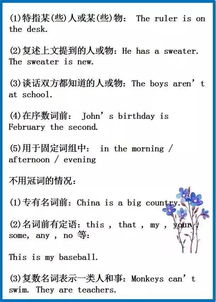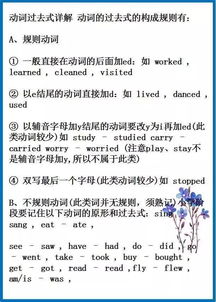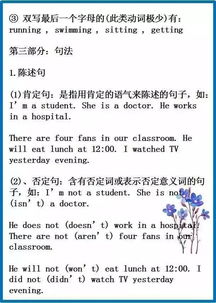小学英语大全6(小学英语知识要点)
1.小学英语知识要点
小学分班考英语不一定难,如果不难的话很容易考,平常考七八十的可以考八九十 但是如果难的话考的一般就不是课内的了 复习好一下几点应该就没有问题 1.一般现在时 定义:一般现在时表示现在经常反复发生的动作、存在的状态或习惯性的动作的时态。
构成:一般现在时用行为动词的原形,但第三人称单数作主语时,动词的词尾要加-S。(一般的动词词尾+S。
以sh/ch/s/x结尾的词+es.以辅音字母+Y结尾的把Y变成i,+es。辅音字母+o结尾的+es.) 形式: 主语+be(表状态)或 主语+动词原形+宾语(表动作) 标志词(时间状语):every…, sometimes, at…, on Sunday uauslly often,never,hardly。
. 用法:1.表示经常的或习惯性的动作,常与表示频度的时间状语连用。 时间状语: always, usually,regularly,every morning/night/evening/day/week,often,sometimes,occasionally,from time to time,twice a week,rarely,seldom,once a month, hardly, ever,never. I leave home for school at 7 every morning. 2.表示主语具备的性格、能力、特征和状态。
I don't want so much. Ann Wang writes good English but does not speak well. 比较:Now I put the sugar in the cup. I am doing my homework now. 3.表示客观事实和普遍真理。 The earth moves around the sun. Shanghai lies in the east of China. 4.在时间状语从句和条件状语从句中,常用一般现在时代替将来时。
5.表示预先计划或安排好的行为。 6.小说故事用一般现在时代替一般过去时。
新闻报道类的内容,为了体现其“新鲜”性,也用一般现在时来表示过去发生的事情。 7.有些表示状态和感觉的动词表示现在发生的具体行为时,只用一般现在时,而不用进行时态。
8.表示现在发生的具体动作或存在的状态 9表示格言或警句中。 Pride goes before a fall. 骄者必败。
☆注意★:此用法如果出现在宾语从句中,即使主句是过去时,从句谓语也要用一般现在时。 例:Columbus proved that the earth is round.. 第一句用一般现在时,用于操作演示或指导说明的示范性动作,表示言行的瞬间动作。
再如:Now watch me, I switch on the current and stand back. 第二句中的now是进行时的标志,表示正在进行的动作的客观状况,所以后句用一般现在时。 5).表示按规定、计划或时间表将要发生的事。
He starts next week. 他下个星期出发。 We leave very soon. 我们很快就离开。
The train starts at 10 o'clock in the morning. 火车将在早上10点开出。 这类用法限于表示“移动”的动词:go去,come来,leave离开,start出发,begin开始, arrive到达,take off起飞,等。
一般现在时Be动词情况 am,is,are也可以做一般现在时的助动词 例如:I am a student. 一般现在时表将来: 1)下列动词:come, go, arrive, leave, start, begin, return,live,fly的一般现在时表将来。这主要用来表示在时间上已确定或安排好的事情(即按照固定时间表将来发生的动作)。
The train leaves at six tomorrow morning. When does the bus start? It starts in ten minutes. 2)倒装句,表示动作正在进行,如: Here comes the bus. = The bus is coming. There goes the bell. = The bell is ringing. 3)在时间或条件句中。 When Bill comes (不是will come), ask him to wait for me. I'll write to you as soon as I arrive there. 4)在动词hope, take care that, make sure that等后。
I hope they have a nice time next week. Make sure that the windows are closed before you leave the room. 基本形式(以do为例): 主动态:do 被动态:doing;be done 过去时:did 第三人称单数形式:does (主语为非第三人称单数) 肯定句:主语+动词原形+其他 否定句:主语+don't+动词原形+其他 一般疑问句:Do+主语+动词原形+其他? 肯定回答:Yes,+ 主语 +do 否定回答:No,+ 主语+don't 注意:do和does后要加动词原形(任何时态都一样) 2.现在进行时 现在进行时(The PresentContinuous Tense). 现在进行时的构成是:主语+be+动词ing〔现在分词〕形式 第一人称+am+doing+sth 第二人称+are+doing +sth 第三人称+is+doing+sth 现在进行时的定义:现在进行时表示现在或当前一般时间正在进行的动作。可以表示有计划的未来。
现在分词变化规则 1.直接+ ing 2.去e+ing 3.重读闭音节,且末尾只有1个辅音字母,双写辅音字母+ing 4.特殊变化:die-dying,lie-lying,tie-tying 5.不规则变化 现在进行时的基本用法: A. 表示现在( 指说话人说话时) 正在发生的事情。 例:We are waiting for you. B. 习惯进行:表示长期的或重复性的动作,说话时动作未必正在进行。
例:Mr. Green is writing another novel. (说话时并未在写,只处于写作的状态。) 例:She is learning piano under Mr. Smith. C.已经确定或安排好的将来活动 I'm leaving for a trek in Nepal next week.(已经安排了) we're flying to Paris tomorrow.(票已经拿到了) D.有些动词(状态动词不用于进行时态) 1.表示知道或了解的动词:believe,doubt,forget,imagine,know, remember,realize,suppose,understand 2.表示“看起来”“看上去"。

2.小学英语最基础语法总结
1.人称代词主格: I we you she he it they宾格: me us you her him it them形容词性物主代词:my our your her his its their名词性物主代词: mine ours yours hers his its theirs北京小升初网2.形容词和副词的比较级(1) 一般在形容词或副词后+erolder taller longer stronger, etc(2) 多音节词前+moremore interesting, etc.(3) 双写最后一个字母,再+erbigger fatter, etc.(4) 把y变i,再+erheavier, earlier(5) 不规则变化:well-better, much/many-more, etc.3.可数词的复数形式Most nouns + s a book –booksNouns ending in a consonant +y - y+ ies a story—storiesNouns ending in s, sh, ch or x + es a glass—glasses a watch-watchesNouns ending in o +s or +es a piano—pianos a mango—mangoesNouns ending in f or fe - f or fe +ves a knife –knives a shelf-shelves小升初网4.不可数名词(单复数形式不变)bread, rice, water ,juice etc.bbs.xschu.com5. 缩略形式I'm = I am you're = you are she's = she is he's = he isit's = it is who's =who is can't =can not isn't=is not etc北京小升初6. a/ana book, a peachan egg an hourxschu.com7. Preposition:on, in ,in front of, between, next to, near, beside, at, behind.表示时间: at six o'clock, at Christmas, at breakfaston Monday on 15th July On National Dayin the evening in December in winter北京小升初网8. 基数词和序数词one – first two-second twenty-twentieth9. Some /anyI have some toys in my bedroom.Do you have any brothers or sisters?小升初网10. be 动词(1) Basic form: am/are/is(2) 肯定和否定句 I am(not) from London.My eyes are(not) small.My hair is(not) long.(3)一般疑问句: Am I a Chinese? Yes, you are. No, you aren't.Are they American? Yes, they are. No, they aren't.Is the cat fat? Yes, it is. No, it isn't.bbs.xschu.com11. there be 结构肯定句: There is a …There are …一般疑问句:Is there …? Yes, there is./ No, there isn't.Are there…? Yes, there are. /No, there aren't.否定句: There isn't …. There aren't….北京小升初12. 祈使句Sit down pleaseDon't sit down, please.xschu.com13. 现在进行时.通常用“now”.形式: be + verb +ingeg: I am(not) doing my homework.You/We/They are(not) reading.He/She/It is(not) eating.北京小升初网动词 —ing 的形式Most verbs +ing walk—walkingVerbs ending in e -e + ing come—comingShort verbs ending in a vowel + a consonant run –running swim—swimming14 一般现在时。
通常用 “usually, often, every day, sometimes”。形式:肯定句:I go to school on foot every day.She goes to school on foot every day.一般疑问句:Do you jump high? Yes, I do. / No, I don't.Does he jump high? Yes, he does. / No, he doesn't.否定句: We don't go to school on Sundays.My mother doesn't like watching TV in the evening.小升初网15. (情态)动词can,must, should 后面直接用动词原形。
eg:1. I / He / She / They can sing.2.You should keep quiet in the library.bbs.xschu.com16. 一般过去时态(a) be 动词的过去式:I/He/she/it was(not)…. You/we/they were….一般疑问句was, were 放在句首。(b) 动词过去式:肯定句: I watched cartoons.She visited the zoo.一般疑问句: Did you read book last night? Yes, I did. No, I didn't.Did she clean the desk just now? Yes, she did. No, she didn't.否定句: They didn't go the the part yesterday.He didn't make model ships last week.(3)动词过去式的变化:规则动词的变化:Most verbs +ed eg. planted,watered,climbed。
Verbs ending in e +d eg liked。Verbs ending in a consonant +y --y +ied eg : study—studiedShort verbs ending in a vowel + a consonant eg: stop --stopped不规则动词的变化:is/am—was,are—were,do—did,have/has—had,make—made,fly-flew/u:/eat—ate,take—took,run—ran,sing—sang,drink—drank 等等北京小升初17. “Wh-” questions.What are you doing?What colour is it?What time is it? What's the time?Which is your watch, the yellow one or the white one?Who's the man with a big nose?Whose bag is it?When is your birthday?Where is my ball pen?Why do you like summer?How many books are there in the school bag?How old is the young man?How much is the toy bear?How do you go to school every day?What are you doing?What colour is it?What time is it? What's the time?Which is your watch, the yellow one or the white one?Who's the man with a big nose?Whose bag is it?When is your birthday?Where is my ball pen?Why do you like summer?How many books are there in the school bag?How old is the young man?How much is the toy bear?How do you go to school every day?xschu.com。

3.小学英语语法知识
in 1.用于世纪,年度,月份,季节之前
如:in 2010,in september,in summer,in 21th century
2.用于表示方位地点(在。里)
如:There is a table in the room
3.与一些动词连用,do well in(擅长于。。);be interestsd in(对。。感兴趣) 等等还有很多相关短语
on 1.用于具体某一天(具体日期几月几日、星期几)之前
如:on november 1st(11月1日) ;on thursday(星期四) ;on weekends(在周末--周六周日)
2.用于表示方位地点(在。上边--通常指有接触面的上方)
例如杯子在桌子上(杯子和桌子有接触面),可以说 The cup is on the table.
at 1.用于具体时刻之前(几点几分)
如,he get up at 6 o'clock every morning.
2.用于表示方位地点,如at home ,at school
3.与一些动词连用,如 be good at(擅长于) ,arrive at(到达某地),stay at home(待在家);look at(看) 等等还有很多相关短语
4.小学英语语法知识
英语语法口诀13条: 1、英语的词类 句子要由词组成, 英语词类有十种: 句中成分用实词, 名、代、动、副、数、形容: 冠、介、连词和感叹, 虚词附加或沟通。
词类功能掌握了, 造句之时好运用。 2、语序歌 主、谓、宾、表同汉语, 定语有同也有异。
状语位置更特殊, 不能全和汉语比。 3、肯定句变一般疑问句 have和be提句首, 其它助词Do开头。
时间、人称由do变, 动词只把原形留。 谓语助词有几个, 第一助词提句首。
4、肯定句变否定句 否定词语加not, 放在be和have后。 其它要加动词do, do的后面加not, 时间、人称由do变, 动词原形总保留。
谓语若是助词多, not紧跟第一个。 5、名词的所有格 名词只变数, 不分主宾格。
人和动物类, 可变所有格。 撇(')后加s, 相当汉语“的”。
时间、距离等, 也变所有格。 6、名词变复数 单数变为复数式, 加上“s”统言之。
下列结尾名词后, 要加“s”先加“e”: 发音[∫][t∫][s]和[z], 或是辅音加“o”时。 有些名词变复数, 词尾变化要注意: “y”前字母是辅音, 一律变“y”为“ie”; 遇到“f/fe”, 有时需要变“ve” 少数名词不规则, 特别情况靠硬记。
7、时间名词前所有介词的速记 年月周前要用in, 日子前面却不行。 遇到几号要用“on”, 上午下午又是“in”。
要说某日上下午, 用on换in才能行。 午夜黄昏用at, 黎明用它也不错。
at也在时分前, 说“差”用to, 说“过”要用past。 8、介词用法歌 介词加宾语, 才能有实意。
表、定、状、宾、补, 词组在句里。 9、介词顺口溜 in 在……里, out在……外, 在旁边的是beside, 靠近的为by。
on在……上, under在……下, above在上头, below在底下。 10、be的用法歌 动词be,变化大, “I”用“am”“You”用“are” Is用于它(it)、他(he)、她(she) 复数一定要用“are”, 切莫用错闹笑话。
11、动词的时态 四种时间各四式, 联想对比便于记。 时间现在和过去, 各自还有将来时。
一般、完成、进行式, 完成进行是四式。 四四共有十六种, 看来复杂掌握易; 除去have/be以外, 动词变化有规律。
12、动词形式的变化 动词根本是原形, 变化形式有四种: 原形词尾加“s”, 现在第三单人称; 过去原形加“ed”, 过去分词也相同; 原形加上“ing”, 现在分词或动名。 原形词尾加“s”, 如同名词复数式。
若加“ed/ing”, 以下情况要注意: 词尾有ie只加d, Ing去掉无声e; 词尾ie变成y, 然后再加ing; 辅音之后y结尾, Y要变i加ed; 现在分词不变y, 直接加上ing; 词尾重读闭音节, 结尾辅音都双写, r做结尾也一样, 重读音节r双写; 结尾字母若是“t”, 不是重读也双写。 过去分词过去式, 不按规则也有些。
13、动词不定式不带to的动词 四看(notice,observe,see,watch), 三使役(have,let,make), 二听(hear,listen to), 一感觉(feel)。 按:在上述动词后做宾语补语用的不定式不带to。
5.人教版六年级英语基础知识复习资料
PEP小学英语毕业总复习 一:学生易错词汇1. a, an的选择: 元音音素开头的单词用an,辅音音素开头的单词用a.2. am , is , are的选择: 单数用is , 复数用are, I 用 am , you 用 are.3. have , has 的选择: 表示某人有某物。
单数用has , 复数用have, I \you 用 have .4. there is, there are 的选择:表示某地有某物或某人。单数用there is , 复数用there are.5. some, any 的选择:肯定句用some, 疑问句和否定句用any.6. 疑问词的选择:what (什么) who (谁) where (哪里) whose (谁的) why(为什么)when(什么时候)which(哪一个)how old (多大) how many (多少)how much(多少钱) 二:形容词比较级详解 当我们需要对事物作出比较时,需要用到比较级。
比较级的句子结构通常是:什么 + 动词be (am , is , are ) + 形容词比较级 + than(比)+ 什么 ,如:I'm taller and heavier than you. (我比你更高和更重。) An elephant is bigger than a tiger. (一只大象比一只老虎更大。)
形容词的比较级是在形容词的基础上变化而来的,它的变化规则是:① 一般的直接在词尾加er ,如 tall - taller , strong - stronger ,② 以e结尾的,直接加r ,如 fine – finer ,③ 以辅音字母加y结尾的,先改y为i再加er,如funny - funnier ④ 双写最后的字母再加er,如big – bigger, thin – thinner ,hot – hotter ☆注意☆ 比较的两者应该是互相对应的可比较的东西。典型错误:My hair is longer than you.(我的头发比你更长。)
比较的两者是我的头发、你(整个人),那么比较的对象就没有可比性。应该改为:My hair is longer than yours. 或My hair is longer than your hair.比较级专项练习: 一、从下面中选出合适的单词完成句子 heavy tall long big(1) How is the Yellow River?(2) How is Mr Green? He's 175cm.(3) How are your feet? I wear size 18.(4)How is the fish? It's 2kg.二、根据句意写出所缺的单词(1) I'm 12 years old. You're 14. I'm than you.(2) A rabbit's tail is than a monkey's tail.(3) An elephant is than a pig.(4) A lake is than a sea.(5) A basketball is than a football.(贵的) 三、根据中文完成句子.(1) 我比我的弟弟大三岁. I'm than my brother.(2) 这棵树要比那棵树高. This tree than that one.(3) 你比他矮四厘米. You are than he.(4) 谁比你重? than you?四、根据答句写出问句(1) I'm 160 cm.(2) I'm 12 years old.(4) Amy's hair is 30 cm long.三:动词过去式详解 动词的过去式的构成规则有:A、规则动词 ① 一般直接在动词的后面加ed:如 worked , learned , cleaned , visited ② 以e结尾的动词直接加d:如 lived , danced , used ③ 以辅音字母加y结尾的动词要改y为i再加ed(此类动词较少)如 study – studied carry – carried worry – worried (注意play、stay不是辅音字母加y,所以不属于此类) ④ 双写最后一个字母(此类动词较少)如 stopped B、不规则动词(此类词并无规则,须熟记)小学阶段要记住以下动词的原形和过去式:sing – sang , eat – ate ,see – saw , have – had , do – did , go – went , take – took , buy – bought , get – got , read – read ,fly – flew , am/is – was ,are – were , say – said , leave – left , swim – swam , tell – told , draw – drew , come – came , lose – lost , find – found , drink – drank , hurt – hurt , feel – felt 四:动词现在分词详解 动词的ing形式的构成规则:① 一般的直接在后面加上ing , 如doing , going , working , singing , eating ② 以e 结尾的动词,要先去e再加ing ,如having , writing ③ 双写最后一个字母的(此类动词极少)有:running , swimming , sitting , getting 五:人称和数 人称代词 物主代词 主格 宾格 第一 人称 单数 I(我) me my(我的) 复数 we(我们) us our(我们的) 第二 人称 单数 you(你) you your(你的) 复数 you(你们) you your(你们的) 第三 人称 单数 he(他) him his(他的) she(她) her her(她的) it(它) it its(它的) 复数 they(他们/她们/它们) them their(他们的/她们的/它们的) 六:句型专项归类1、肯定句:是指用肯定的语气来陈述的句子,如:I'm a student. She is a doctor. He works in a hospital. There are four fans in our classroom. He will eat lunch at 12:00. I watched TV yesterday evening.2、否定句:含有否定词或表示否定意义词的句子,如:I'm not a student. She is not (isn't) a doctor. He does not (doesn't) work in a hospital. There are not (aren't) four fans in our classroom. He will not (won't) eat lunch at 12:00. I did not (didn't) watch TV yesterday evening.☆注意☆ 小结:否定句主要是在肯定句的基础上加上了否定词 “not”。
有动词be的句子则“not”加在be后面,可缩写成“isn't,aren't”,但am not 一般都分开写。没有动词be的句子则要先在主要动词的前面加上一个助动词(do,does,did),然后在它后面加上“not”,你也可以把它们缩写在一起如“don't , doesn't , didn't )。
这三个助动词要根据人称和时态来选择,其中“does”只用于一般现在时主语是第三人称单数的情况,而“did”只用于一般过去时,不论主语是什么人称和数,。
6.小学生英语语法知识有哪些
英语语法是分类的,分为词法和句法。
小学英语语法和初中以及高中相比较,只是在语法数量和难易程度上有差别。小学阶段都是很基础的知识点。最关键的是在初中和高中。
首先,小学英语词法包括:
1、代词(人称代词:主格以及宾格;物主代词:形容词性物主代词和名词性物主代词;反身代词;指示代词还有疑问代词);
2、名词语法(名词分类,单复数,以及名词所有格);
3、介词(常考的就是时间和地点介词,on in at等);
4、数词(基数词和序数词)
5、冠词(零冠词,不定冠词和定冠词)
6、形容词和副词以及他们的比较级和最高级
小学词法大概就这些。
其次,小学句法一般包括:
1、句型转换(肯定句,否定句,一般疑问句和特殊疑问句等)
2、特殊句型:祈使句,感叹句,以及there be 句型等
3、句子结构和成分分析(主谓宾、定状补等)
总之,英语有些方面是有一些规律可循的,但是英语还有它另外一个显著的特点,那就是知识点零碎、分散,想要学好英语,那就需要你在听懂老师讲解的基础上,课下好好背诵该背的知识。
如有不全面之处,还请补充。希望采纳。Thanks。
7.六年级英语知识点
小升初六年级英语语法知识复习全面汇总2013-09-16 一、词类: 动词、名词和形容词不太容易区分,如不能一眼看出,可用如下方法: 先用“一(量词)”(如:一个、一张等)和这个词连起来说,如说得通,一般认为是名词;说不通再用“很”去判断,就是把“很”和为个词连起来说,说得通一般就是形容词;都说不通就是动词。
(目前我们学过的,以后可能不同)(另外一些很明显的,如人称代词、数词、情态动词等一下就可以知道) 1、动词 这里所说的动词是指各种动词总称,其中包括行为动词(就是我们平时总说的那种动词)、be动词、情态动词。 (1)行为动词 就是我们平时上课时说的动词,表示某一动作或行为。
如:sweep、live等。 行为动词我们已学过它们的四种形式: 原形、+s/es、+ed、+ing,具体判断方法如下: ↗有,就加ing 读句子→读该单词→认识该单词→理解意思→看有无be动词 (若是be going to 就用原形) ↘没有,再看情态动词 ↗有,就用原形 ↗有,就加ed ↘没有,再看有无表示过去的时间状语 ↗是第三人称单数就加s或es ↘没有,再看主语 ↘不是第三人称单数就用原形 (2)be动词 a、Am--was Is --was Are--were 口诀:我用am, 你用are, is用在他她它,所有复数全用are。
b、肯定和否定句 I am (not) from London. He is(not) a teacher. She is(not) in the dining room. My hair is(not) long. Her eyes are(not) small. c、一般疑问句 Am I a Chinese? Yes, you are. No, you aren't. Are they American? Yes, they are. No, they aren't. Is the cat fat? Yes, it is. No, it isn't. 我们现在学过的be动词大致分两类:is、am、are为一类,一般用于一般现在时、现在进行时和一般将来时中,was和were为另一类,一般用于一般过去时。 判断步骤: ↗第一、三人称单数,就用was ↗有,再看人称 ↘第二人称单数和所有复数,就用were 看有无表示过去的时间状语 ↗第一人称单数,就用am ↘没有,再看人称→第三人称单数,就有is ↘第二人称单数和所有复数,就用are (3)情态动词 情态动词也是一类特殊的动词,平时我们不把它说成是动词。
情态动词可以和行为动词同时出现在同一个句子中。 我们现在学过的情态动词有:can、must、should、would、may。
接触最多的是can。 情态动词后动词总是用原形。
(不受其他任何条件影响) 2、名词 表示某一事物,有具体的和抽象的之分。判断的关键词往往是be动词,be动词如果是am、is或was,名词就用原形;be动词如果是are或were,名词就加s或es。
这里强调两点:不可数名词都默认为单数,所以总是用is或者was;最好不要根据some、any、a lot of等词去作判断,以免受误导。 如何加后缀: a.一般情况下,直接加-s,如:book-books, bag-bags, cat-cats, bed-beds b.以s. x. sh. ch结尾,加-es,如:bus-buses, box-boxes, brush-brushes, watch-watches c.以“辅音字母+y”结尾,变y为i, 再加-es,如:family-families, strawberry-strawberries d.以“f或fe”结尾,变f或fe为v, 再加-es,如:knife-knives e.不规则名词复数: man-men, woman-women, policeman-policemen, policewoman-policewomen, mouse-mice child-children foot-feet ,.tooth-teeth fish-fish, people-people, Chinese-Chinese, Japanese-Japanese 判断步骤: ↗如是am、is或was→原形 读句子→读该单词→认识该单词→理解意思→看be动词 ↘如是are或were→加s或es 3、形容词(包括副词) 形容词表示某一事物或的特征,副词表示某一动作的特征。
形容词和副词只有两种形式:原形和+er。 未作比较的情况下就用原形,比较时就+er。
两个重要特征:as……as中间一定用原形,有th。
8.小学英语知识
1、小学英语介词at,in与on在时间方面的用法 at表示时间的一点;in表示一个时期;on表示特殊日子。
如: He goes to school at seven o'clock in the morning. 他早晨七点上学。 Can you finish the work in two days. 你能在两天内完成这个工作吗? Linda was born on the second of May. 琳达五月二日出生。
1>. at后常接几点几分,天明,中午,日出,日落,开始等。如: at five o'clock (五点),at down (黎明),at daybreak (天亮),at sunrise (日出),at noon (中午),at sunset (日落),at midnight (半夜),at the beginning of the month (月初), at that time (那时),at that moment (那会儿),at this time of day (在一天的这个时候)。
2>. in后常接年,月,日期,上午,下午,晚上,白天,季节,世纪等。如: in 2006(2006年),in May,2004 (2004年五月),in the morning (早晨/上午),in the afternoon (下午),in the evening (晚上),in the night (夜晚),in the daytime (白天),in the 21st century (21世纪),in three days (weeks/month)三天(周/个月),in a week (一周),in spring (春季)。
3>. on后常接某日,星期几,某日或某周日的朝夕,节日等。如: on Sunday (星期日),on a warm morning in April (四月的一个温暖的上午),on a December night (12月的一个夜晚),on that afternoon (那天下午),on the following night (下一个晚上),on Christmas afternoon (圣诞节下午),on October 1,1949 (1949年10月1日),on New Year's Day (新年),on New Year's Eve (除夕),on the morning of the 15th (15日的早上)等。
2、巧记形容词的排列顺序 当两个以上形容词修饰一个名词,形容词该如何排 列?为什么不能说a black new pen,而是说成a new black pen? 这里面有无规则可循? 如果你记住opshacom这个为帮助记忆而杜撰的词, 就能掌握英语中形容词排列的顺序。 opshacom中p代表opinion,指表示人们观点的形容 词,如beautiful,horrible,lovely,nice等; sh代表shape,指表示形状的形容词,如long,short,round, narrow等; a代表age,指表示年龄、时代的形容词,如old,new,young等; c代表colour,指表示颜色的形容词,如red,black, orange等; o代表origin,指表示国籍、地区的形容词,如british,canadian,german等; m代表material,指表示材料的形容词,如plastic,metal,aluminium等。
英语中这六类形容词连用时就按上述先后顺序排列, 如a nice long new black british plastic pen 当然,实际语言使用中不可能出现这么多形容词连 用的情况。 请根据形容词排列规则完成以下练习: 1>.she has a ___ jacket.(leather,brown,beautiful) 2>.he has a ___ car. (american,long,red) 3>.they live in a ___ house. (old,beautiful) 4>.we have a ___ table. (antique,small,wooden) 5>.he has a ___ jumper. (woollen, lovely, red) 6>.she has a ___ ring. (diamond,new,fabulous) 7>.it was a ___ song.(french,old, lovely) 8>.he owns a ___ dog.(black,horrible,big) 9>.she bought a ___ scarf.(gorgeous,silk,pink) 一、一般现在时主要用于: 1 、表示经常性或习惯性动作。
e.g. It seldom snows here. 2 、表示现在的特征或状态。 e.g. He is always ready to help others. 3 、普遍真理。
e.g. Action speaks louder than words. 4 、剧情图片介绍,背景说明,动作解说。 e.g. (Tom enters the room_and_sits at the table) Doctor : What`s your trouble, young man? Tom : I`ve caught a cold, doctor. 5 、时间、条件、让步、方式状语从句表将要发生的动作时。
e.g. Tomorrow we shall go for an outing unless it rains. 与这种时态连用的时间状语常有: always, often, never, seldom, usually, once, a week, now 等。 二、一般过去时主要用于: 1 、表示过去某个时间发生的动作或情况(包括习惯性的动作或状态) e.g. When did you read the novel? She often came to help us in those days. 2 、谈到过去的情况时 e.g. I didn`t know you were so busy. 3 、谈到已死人的情况时 e.g. Lei Feng was a great communist fighter. 与这个时态连用的时间状语常有: yesterday, last night, the other day, two months ago, in 1985, then, just now, when, after, as soon as 引导的时间状语从句,表示主句动作开始的时间。
三、现在完成时主要用于: 1 、表示到现在为止这一时期中发生的动作或情况,即多次动作的总和。 e.g. We have learnt four English songs this month. How many times have you read the novel? For many days we haven`t seen each other. 2 、表示对现在有影响的某一已发生的动作。
e.g. The delegation has left 代表团已经走了(说明现在不在这里) Look, what you have done. 看你干的事。 与这一时态连用的时间状语有: already, yet, just, ever, never, by now, so far, recently, by the end of this month, since, for 短语,连词 since 引导的时间状语从句。
一般过去时与现在完成时的区别: 一般过去时:重在说明动作在过去发生时的具体情况(时间、地点、方式、对象、细节等)。 现在完成时:只提起已发生的动。

相关推荐
声明:本网站尊重并保护知识产权,根据《信息网络传播权保护条例》,如果我们转载的作品侵犯了您的权利,请在一个月内通知我们,我们会及时删除。
蜀ICP备2020033479号-4 Copyright © 2016 学习鸟. 页面生成时间:3.213秒









